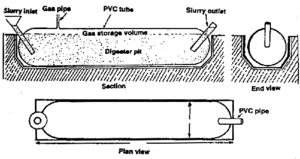Polyethelene Tube Digesters, also known as balloon biogas plants,[1] are a type of biodigester quickly gaining popularity in applications throughout the world. Due to their simple construction, easily understandable mechanics, widely available inexpensive material, and versatile structure, polyethylene tube digesters are ideal for initial "test" conversions in small-scale applications.[2]

A polyethylene tube biodigester is typically characterized by a raised inlet trough, a long, flexible fermenting reservoir with a gas vent tube, and a slurry output.
The exceedingly simple design and low cost of a PET digester and its lack of moving parts means that the system is inherently reliable and cost effective. However, the design may be short-lived in comparison to more traditional digesters (e.g. Fixed dome digester, Floating drum biogas digestor) due to its construction from polyethylene plastic, which will degrade over time. However, the low cost and easy installation of the digester bag means that the main chamber is simple to replace in the event degradation begins to affect the system's performance. Though the gas inside is being pushed out only by the pressure of the other methane gas inside the digester, the flexible reservoir allows the flow rate to be modified simply by applying additional pressure to the bag- say by placing a rock on it.[3]
Pros[edit | edit source]
- Simple setup
- Low cost
- Shallow installation, ideal for areas with high groundwater table
- Easy to see how much gas is available
- Easily warmed, ideal for warmer climates
Cons[edit | edit source]
- Not as durable as traditional digesters
- Low gas pressure
- Production time highly dependent on ambient temperature
Comparisons to other digester types[edit | edit source]
- Lower gas output (depending on size)
- Lower pressure consistency
- Similarly easy to gauge amount of gas available for use
- Less insulated
- Easier to maintain
- Less expensive
- Lower gas output (depending on size)
- Similar pressure consistency
- Easier to gauge amount of gas available for use
- Less insulated
- Easier to maintain
- Less expensive
Humboldt State Biobolsa Project[edit | edit source]
For full article, see Practivistas Chiapas biodigester
In conjunction with the International Renewable Resources Institute, Humboldt State's Practivistas program installed a polyethylene tube biodigester in Chiapas, Mexico in order to foster awareness of the technology and encourage the growth of such systems throughout the area. The digester was installed at an eco-home that serves as a model of appropriate technology for the region, and cost $13270.5 pesos. It is expected to pay for itself in just over a year.